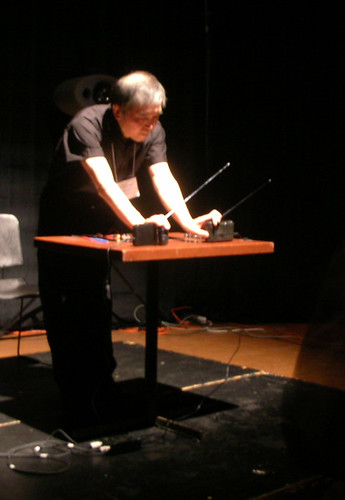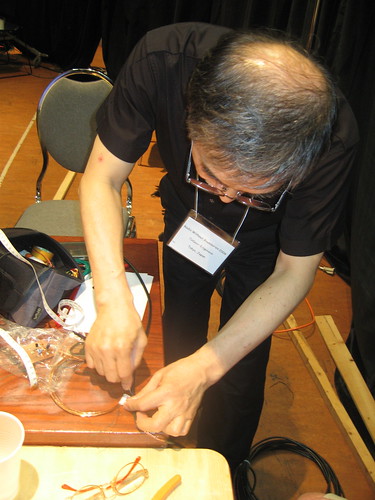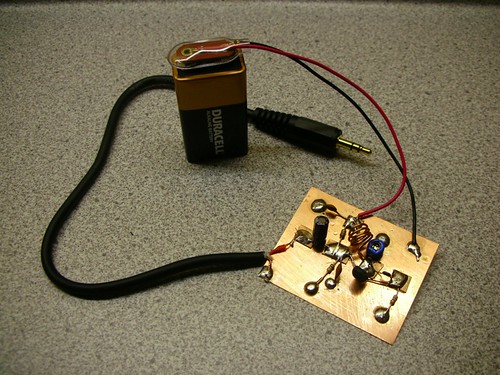 The conference was a wonderful experience.
The conference was a wonderful experience.
Highlights, moments of curiosity, and conviviality: conversations with Trademark G, who performed on Saturday; capturing a spontaneous conversation about listening and the conference on my DAT with Amber and Andrea from Union Docs in Brooklyn; meeting Chantal Dumas; hanging out with Anna Friz, Peter Courtemanche, Glen Gear, who performed on Friday night as Absolute Value of Noise…and with Justin Groteleuschen, who helped Anna and me out last year when we toured to Boston, and wrote about this conference for Transom.org.
Tetsuo Kogawa’s workshop, talk, and performance were superb. You’ll get a sense of what his performance was like by viewing and listening to Justin Groteleuschen’s clips on his Vimeo site: http://www.vimeo.com/user512919/videos. Please read his Deep Wireless report on Transom.org. Justin also has a good set of photos from the conference on his Flickr photostream, and I added a few photos to my own Flickr site, and this video on [kml_flashembed movie=”http://www.youtube.com/v/rrBQVaNBwLk” height=”350″ width=”425″ /]
To see Tetsuo Kogawa’s diagrams, tools, “howto”, peripherals, and histories visit How to build a micro transmitter. He has done a great job of providing this information in English. For a direct tutorial web page including circuit schematics, go to Kogawa’s “How to build the most simplest FM transmitter?”
Keynote Address: Re-examining radio art by Tetsuo Kogawa
A talk and performance given at the Deep Wireless Radio Without Boundaries conference in Toronto, on Sunday, June 1, 2008
Keynote description from the New Adventures In Sound Art (NAISA) website

Kogawa is credited with starting free radio in Japan. He studied and teaches philosophy there, and uses the ideas of Felix Guattari to frame his own concept of radio and transmission art. Rather than belabor you with all that this richly implies, this statement encapsulates his concept nicely. Quoting from Kunstradio’s announcement of Tetsuo’s October 2007 live broadcast from Musikprotokoll, Graz:
“My performance consists of radio transmitters/receivers and my hands that wave over them. Every space of my performance has different airwave conditions. But the point is to create resonances and fluctuations of airwaves and to crystallize them into the sounds or/and images. I think radio must be understood as radiation. Radiation is communication of ‘messages’ as well as artistic imagination. I am more interested in the latter function. Radio is based on the electronic transmission. This transmission is between mind and body, and brain and hands. Radio could give a model to link different zones of our body and our outer worlds. In the microscopic scale of our body, we have neurotransmitters while in the macro scale we have hands. By my hand-waving transmission, I move between virtual and physical areas, technology and techne (τέχνη) which originally means handwork.”
—Tetsuo Kogawa
My quick web search for an online version of Kogawa’s talk revealed many references, but not the actual text of “Re-examining radio art”. Kogawa’s main page seems the best source for searching and learning about his ideas and work. One interesting link is a paper by Sarah E. Kanouse on transmission and memory. The PDF download link is here.
My search also reminded me that the latest issue of Leonardo Music Journal, LMJ17 makes mention of Tetsuo Kogawa. This is the same issue that carries my article on the Springboard. The companion CD compiled by Sarah Washington, entitled the Art of the Gremlin, has one track by Knut Auferman with Tetsuo Kogawa entitled fm:i/o.
As he stated in his talk, Tetsuo isn’t interested in radio-as-broadcast, “…free radio does not broadcast (scatter) information but communicates (co-unites) messages to a concrete audience.” In my hands it certainly is a radio-as-instrument, and Tetsuo demonstrated this most completely and convincingly in his performance.
This one-minute video from Sunday’s performance doesn’t give the full effect, but does hint at how the Tetsuo uses the proximity of a single trnasmitter to manipulate the sound.
“In accordance with my re-examination of the concept of transmission, I would like to demonstrate a short example to ‘parenthesize’ the “messages” of transmission and to let the airwaves emancipate themselves.”
This is the sort of radio I’m most interested in. It connects the cultures of radio art, hardware hacking, and electronic music performance to one another. In the context of broadcasting it blurs the traditional roles of the sender and receiver making this relationship into one where you or I can easily become a sender-receiver, or a transceiver. The activity of “transception”—on the micro-scale-transmission range of one meter-that Kogawa is interested—results in radio that merges radiation in the electro-magnetic spectrum with the capacitance of his own body.
 Here’s a photo of the transmitter I built on Saturday, which was part 1 of the workshop. In part 2, participants built antennas for their transmitters with coaxial cable, as shown in Justin’s photos. I’ve received useful knowledge from the Radio Without Boundaries conference on radio and transmission art, with applications in my own performance in hand and for potential student projects. I used the FM transmitter I built in Wednesday night’s rehearsal with Auris, and want to experiment with it further.
Here’s a photo of the transmitter I built on Saturday, which was part 1 of the workshop. In part 2, participants built antennas for their transmitters with coaxial cable, as shown in Justin’s photos. I’ve received useful knowledge from the Radio Without Boundaries conference on radio and transmission art, with applications in my own performance in hand and for potential student projects. I used the FM transmitter I built in Wednesday night’s rehearsal with Auris, and want to experiment with it further.
Hopefully, there will be audio transcripts of the Radio Without Boundaries sessions available so that anyone interested in art, sound, and radio will be able to learn and grow.
